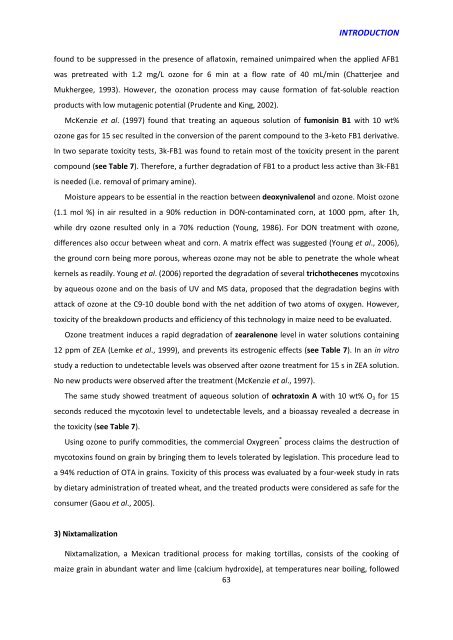Effet chez le porcelet d'une exposition à un régime co-contaminé en ...
Effet chez le porcelet d'une exposition à un régime co-contaminé en ...
Effet chez le porcelet d'une exposition à un régime co-contaminé en ...
Create successful ePaper yourself
Turn your PDF publications into a flip-book with our unique Google optimized e-Paper software.
INTRODUCTIONfo<strong>un</strong>d to be suppressed in the pres<strong>en</strong>ce of aflatoxin, remained <strong>un</strong>impaired wh<strong>en</strong> the applied AFB1was pretreated with 1.2 mg/L ozone for 6 min at a flow rate of 40 mL/min (Chatterjee andMukhergee, 1993). However, the ozonation process may cause formation of fat-solub<strong>le</strong> reactionproducts with low mutag<strong>en</strong>ic pot<strong>en</strong>tial (Prud<strong>en</strong>te and King, 2002).McK<strong>en</strong>zie et al. (1997) fo<strong>un</strong>d that treating an aqueous solution of fumonisin B1 with 10 wt%ozone gas for 15 sec resulted in the <strong>co</strong>nversion of the par<strong>en</strong>t <strong>co</strong>mpo<strong>un</strong>d to the 3-keto FB1 derivative.In two separate toxicity tests, 3k-FB1 was fo<strong>un</strong>d to retain most of the toxicity pres<strong>en</strong>t in the par<strong>en</strong>t<strong>co</strong>mpo<strong>un</strong>d (see Tab<strong>le</strong> 7). Therefore, a further degradation of FB1 to a product <strong>le</strong>ss active than 3k-FB1is needed (i.e. removal of primary amine).Moisture appears to be ess<strong>en</strong>tial in the reaction betwe<strong>en</strong> deoxyniva<strong>le</strong>nol and ozone. Moist ozone(1.1 mol %) in air resulted in a 90% reduction in DON-<strong>co</strong>ntaminated <strong>co</strong>rn, at 1000 ppm, after 1h,whi<strong>le</strong> dry ozone resulted only in a 70% reduction (Yo<strong>un</strong>g, 1986). For DON treatm<strong>en</strong>t with ozone,differ<strong>en</strong>ces also occur betwe<strong>en</strong> wheat and <strong>co</strong>rn. A matrix effect was suggested (Yo<strong>un</strong>g et al., 2006),the gro<strong>un</strong>d <strong>co</strong>rn being more porous, whereas ozone may not be ab<strong>le</strong> to p<strong>en</strong>etrate the who<strong>le</strong> wheatkernels as readily. Yo<strong>un</strong>g et al. (2006) reported the degradation of several trichothec<strong>en</strong>es my<strong>co</strong>toxinsby aqueous ozone and on the basis of UV and MS data, proposed that the degradation begins withattack of ozone at the C9-10 doub<strong>le</strong> bond with the net addition of two atoms of oxyg<strong>en</strong>. However,toxicity of the breakdown products and effici<strong>en</strong>cy of this technology in maize need to be evaluated.Ozone treatm<strong>en</strong>t induces a rapid degradation of zeara<strong>le</strong>none <strong>le</strong>vel in water solutions <strong>co</strong>ntaining12 ppm of ZEA (Lemke et al., 1999), and prev<strong>en</strong>ts its estrog<strong>en</strong>ic effects (see Tab<strong>le</strong> 7). In an in vitrostudy a reduction to <strong>un</strong>detectab<strong>le</strong> <strong>le</strong>vels was observed after ozone treatm<strong>en</strong>t for 15 s in ZEA solution.No new products were observed after the treatm<strong>en</strong>t (McK<strong>en</strong>zie et al., 1997).The same study showed treatm<strong>en</strong>t of aqueous solution of ochratoxin A with 10 wt% O 3 for 15se<strong>co</strong>nds reduced the my<strong>co</strong>toxin <strong>le</strong>vel to <strong>un</strong>detectab<strong>le</strong> <strong>le</strong>vels, and a bioassay revea<strong>le</strong>d a decrease inthe toxicity (see Tab<strong>le</strong> 7).Using ozone to purify <strong>co</strong>mmodities, the <strong>co</strong>mmercial Oxygre<strong>en</strong> ® process claims the destruction ofmy<strong>co</strong>toxins fo<strong>un</strong>d on grain by bringing them to <strong>le</strong>vels to<strong>le</strong>rated by <strong>le</strong>gislation. This procedure <strong>le</strong>ad toa 94% reduction of OTA in grains. Toxicity of this process was evaluated by a four-week study in ratsby dietary administration of treated wheat, and the treated products were <strong>co</strong>nsidered as safe for the<strong>co</strong>nsumer (Gaou et al., 2005).3) NixtamalizationNixtamalization, a Mexican traditional process for making tortillas, <strong>co</strong>nsists of the <strong>co</strong>oking ofmaize grain in ab<strong>un</strong>dant water and lime (calcium hydroxide), at temperatures near boiling, followed63

















